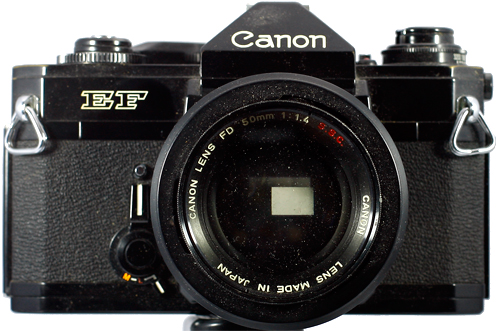
Lens Mount: FD bayonet/breech
Format: 35mm film
Approx. dates of manufacture: 1973
Approx. original price: $379.95
Approx. street value: High-moderate
Some people say this is the electronic version of the Canon F-1, but I think it's an electronic version of the FTb: both of those cameras were metal mechanical cameras and both had CdS match-needle metering. But the F-1 accepted special accessories that no other camera took: motor drives, backs, pentaprisms. The F-1 had a top speed of 1/2000th of a second, the FTb and the EF both topped out at 1/1000th. They were also priced about the same.
What made the EF special was what separated it from everything at the time: it used a Silicon photocell instead of CdS (the Silicon cell would become standard beginning with the AE-1), it had a vertical-travel metal blade Copal square shutter (which began and ended with the EF), and it had shutter-priority automatic exposure capability. My favorite feature is that unlike match-needle, and unlike the AE-1 which only had the aperture scale, the EF had both the shutter speed and the aperture scale visible within the viewfinder. You don't have to take your eye out of the finder to figure out how the camera is set. That feature wouldn't reappear until the A-1 came out in 1978.
.jpg) I have a theory why people think of it as a sister to the F-1. Camera companies tend to copy
famous makes and looks. Franke & Heidecke made their famous Rolleiflex in the late 20s and
modern TLRs (like the Mamiya C220 or the chinese Seagulls)
still look like it. Somewhere in the 30s, Leica 35mm cameras were bare metal with black leather (or leatherette) around
the middle, and most other 35mm cameras followed that lead. When 35mm SLRs came out, they continued the tradition: black leather in the middle and "silver" (as
it's described in the ads) on the top and bottom.
I have a theory why people think of it as a sister to the F-1. Camera companies tend to copy
famous makes and looks. Franke & Heidecke made their famous Rolleiflex in the late 20s and
modern TLRs (like the Mamiya C220 or the chinese Seagulls)
still look like it. Somewhere in the 30s, Leica 35mm cameras were bare metal with black leather (or leatherette) around
the middle, and most other 35mm cameras followed that lead. When 35mm SLRs came out, they continued the tradition: black leather in the middle and "silver" (as
it's described in the ads) on the top and bottom.
Somewhere in the late 60s, I'm not sure why, the professional grade 35mm SLRs went all-black, and the all-black SLR became a symbol of professional-level cameras and the silver models were amateur (or advanced-amateur) level. The Nikon F2 came in both silver and black, but the F3 and subsequent models were all black. Canon's F-1 and A-1 were only available in black. It's advanced-amateur cameras like the FTb, AE-1 and AE-1 Program were normally sold in silver but could be purchased in all-black for an additional fee. You can still see this today: Canon's high end digital SLRs are all-black, but its entry-level Digital Rebel is silver (but you can buy an all-black version for another $75).
The point is that all-black is professional, silver is amateur. The F-1 was all-black, the FTb was silver.
The EF only came in black.
I've always wanted one of these. The faculty advisor for the year book staff where I went to high school had one, and she loved it. I had an AE-1 and I loved it but I was jealous anyway. For all I know this may well be hers. Anyway, I finally got this one, another thrift-shop purchase, for around $100. My camera's a bit scratched but still in good shape, so it's a bit undervalued. Plus it came with two Canon (not 3rd party) lenses and a Canon flash I'd wanted for another camera, so I got a good deal indeed.
The other nifty thing is that I can still use it. The mechanical shutter runs without a battery at speeds above 1 second. It takes two 1.35v mercury batteries, which are no longer available, but supposedly the electronics inside allow it to use the modern 1.5v equivalents without having to recalibrate the meter (that turned out to be wrong. I put two 1.5v "equivalents" in it and the meter runs way too high).
For more information: Canon Camera Museum
Modern Photography magazine camera test: May 1974
One of Modern Photography magazine's Top Cameras
Camera manual: Orphan Cameras.com



